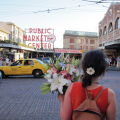PIKE PLACE MARKET
It is Seattle's most renowned commercial and cultural institution. It is also one of the largest and oldest markets in the United States.
History. In 1907, Seattle Mayor Charles A. Burett, instituted a free market day on which farmers could sell their products directly to consumers to lower the exorbitant price of food by allowing farmers to sell their products directly at reasonable prices. Gradually, buildings and shopping malls replaced trucks and carts, without preventing the market from developing freely, soon occupying the entire hillside. In 1927, more than 400 farmers gathered on Pike Place and following the 1929 crisis, the market became the nerve centre of Seattle.
During the Second World War, the market declined. The city defended it, the market being an inseparable part of Seattle's history and future. Today, the Pike Market occupies two floors below street level. They are occupied by curiosity shops, restaurants... The Pike Market Hill Climbs Corridor connects the upper level with the waterfront through a series of stops with green spaces.
Since the 1960s, there have been as many market gardeners as there are artists and florists. The market with its colourful stalls of regional products or handicrafts, the moving crowd, the cries, the smell of the tide, the booksellers and the antique dealers constitute a living picture that many painters have enjoyed restoring. Tourists hurry to watch the famous fish throw (fishmongers throw the fish at each other screaming when there is an order). The neighbourhood is now classified, and that's good.
Visit in practice: some definitions must be given to some words used in this market. Highstalls are permanent displays of fresh produce. Farm Tables are low metal tables where local products are occasionally displayed.
The market is spread over several floors, so don't hesitate to explore it, to go down the small stairs not necessarily very welcoming at first sight or to explore the surrounding alleys. All around the market, there are dozens of shops, restaurants and producers all year round. The best known is certainly the Original Starbucks brand, which holds its very first coffee shop here in 1971. Expect a nice line of tourists waiting for a latte or cappuccino. You can also have a butter croissant at Le Panier, a French bakery that offers the best of French pastry... but with an American sauce (price and taste). There are also many souvenir shops in the area. One of the best is certainly Made in Washington which offers articles made by artists from the region and sometimes unfortunately a little hidden by the made in China.
Good plan. Feel free to taste what we have to offer, the market traders are happy to have their products tested, take a walk and let your taste buds travel! Avoid going there on Saturdays and Sundays that are too busy, and at the end of the market when it starts to fold around 4:30 pm.
To see. Don't forget to save a few pennies for Rachel the Bronze Pig, the huge sculpture in the shape of a sow at the market entrance. This work is in fact a piggy bank that helps several local charities every year. You can also take a detour to the Gum Wall and its chewing gum-covered facades. Then go down to Victor Steinbrueck Park (facing Puget Sound, to the north). And also visit the nearby Seattle Art Museum, another must-see tourist attraction and culture in the Pike Place Market area.
Guided tours of the market and the district, lasting from one to several hours, are organized (see guided tour). You can choose a thematic tour with the best local brands, emblematic restaurants or behind the scenes of the market (for early risers) as the subject. Also check out the events (on the market website): cooking classes, street concerts, festivals and other events are organised all year round.
Did you know? This review was written by our professional authors.
Members' reviews on PIKE PLACE MARKET
The ratings and reviews below reflect the subjective opinions of members and not the opinion of The Little Witty.











